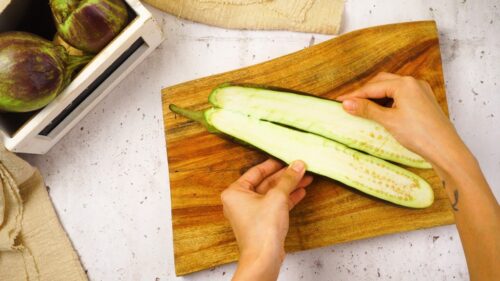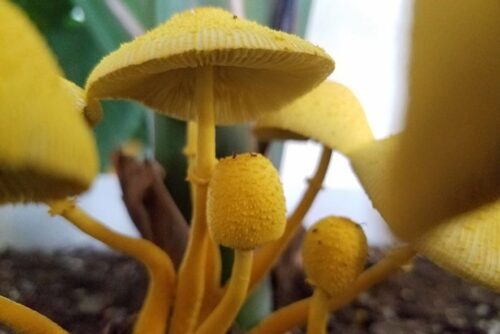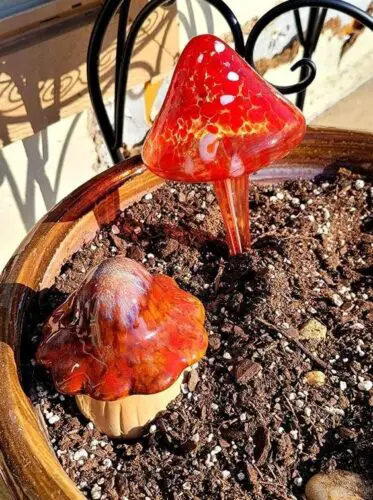To get rid of yellow mushrooms in houseplants, remove the mushrooms and limit moisture in the soil. Yellow mushrooms in houseplants can be a sign of excessive moisture levels in the soil, which can be harmful to the plants.
Proper drainage and airflow are essential to prevent the growth of mushrooms in houseplants. It is also important to avoid overwatering and to ensure that the plants receive adequate sunlight. By following these steps, you can effectively address and eliminate yellow mushrooms in your houseplants, promoting a healthy growing environment for your plants.
Identifying Yellow Mushrooms
Before tackling the issue of yellow mushrooms in your houseplants, it’s crucial to accurately identify these intruders. Understanding their appearance and common types can help in devising an effective eradication strategy.
Appearance
Yellow mushrooms in houseplants typically have a vibrant hue, often with slimy caps and a delicate, spore-filled structure. They may appear in clusters or spread sporadically throughout the soil.
Common Types
Two common types of yellow mushrooms found in houseplants are the Golden Spindles and the Lemon Drops. The Golden Spindles are characterized by their slender stems and iconic bright yellow caps. On the other hand, the Lemon Drops feature a rounder, lemon-shaped cap with a striking yellow coloration.

Credit: www.newzealandrabbitclub.net
Causes Of Yellow Mushrooms In Houseplants
Understanding the causes of yellow mushrooms in houseplants is crucial in effectively resolving this issue. Several factors contribute to the growth of these unsightly fungi, including poor drainage, overwatering, and unfavorable environmental conditions.
Poor Drainage
Poor drainage in houseplants creates stagnant water, promoting the growth of yellow mushrooms.
Overwatering
Overwatering leads to excessive moisture in the soil, providing an ideal environment for yellow mushrooms to thrive.
Environmental Conditions
Factors like high humidity and lack of air circulation can contribute to the development of yellow mushrooms in houseplants.
Potential Risks And Concerns
Yellow mushrooms in houseplants can pose various potential risks and concerns. These fungi may indicate overwatering, poor drainage, or decaying organic matter in the soil. If not addressed, they can lead to root rot and affect the overall health of the plants.
It is important to identify the underlying cause and take appropriate measures to eliminate the mushrooms and prevent their reoccurrence.
Potential Risks and Concerns Toxicity Parasitic mushrooms carry toxic substances that can harm pets or kids. Spread of Spores Yellow mushrooms spread spores quickly, impacting other plant areas. Yellow mushrooms contain harmful toxins dangerous to touch or ingest. Contact with yellow mushrooms can cause skin irritations or allergies. To prevent risks, wear gloves and avoid direct contact with yellow mushrooms.

Preventing Yellow Mushrooms
Yellow mushrooms can be a common issue for houseplants, but there are several preventive measures you can take to keep them at bay. By paying attention to factors such as the potting mix, drainage, watering, and ventilation, you can create an environment that discourages the growth of these unsightly fungi.
Choosing The Right Potting Mix
Use a quality potting mix that is well-draining and contains a good balance of organic matter. Avoid overly dense or nutrient-rich mixes that can promote fungal growth.
Improving Drainage
Ensure the pots have adequate drainage holes and use a layer of gravel at the bottom to prevent waterlogging. This will discourage the growth of mushrooms that thrive in damp conditions.
Watering Carefully
Water your plants carefully, allowing the soil to dry out slightly between waterings. Overly moist soil creates the perfect environment for yellow mushrooms to take hold.
Maintaining Proper Ventilation
Avoid placing houseplants in areas with poor air circulation. Good ventilation helps to prevent moisture buildup, which can contribute to the growth of yellow mushrooms.
Removing Yellow Mushrooms
Yellow mushrooms in houseplants can be a nuisance, but with the right approach, you can get rid of them. Lotusmagus shares effective methods to remove yellow mushrooms from your indoor plants, helping you maintain a healthy and fungus-free environment.
If you have been noticing yellow mushrooms popping up in your houseplants, don’t panic! Dealing with these unwanted guests is easier than it may seem. With the right techniques, you can eliminate yellow mushrooms from your indoor plants and ensure a healthy and beautiful environment for your green friends. In this section, we will explore two effective methods for removing yellow mushrooms: manual removal and using fungicides.
Manual Removal
When it comes to removing yellow mushrooms from your houseplants, manual removal is a simple yet effective method. Here’s how you can go about it:
- Begin by wearing a pair of rubber gloves to protect your hands.
- Gently lift the affected plant out of its container, being careful not to damage the roots.
- Inspect the soil around the base of the plant and locate the yellow mushrooms.
- Using your gloved hand, carefully pluck the mushrooms from the soil, ensuring you remove the entire mushroom, including the base.
- Place the mushrooms in a plastic bag and seal it tightly to prevent spores from spreading.
- Dispose of the bag in an outdoor trash bin.
- Once you have removed the mushrooms, it’s important to monitor your houseplant and its soil regularly to ensure no new mushrooms emerge.
- Ensure your plant receives proper watering and sunlight to discourage the growth of mushrooms.
Using Fungicides
If manual removal doesn’t completely eliminate the yellow mushrooms, you can turn to fungicides for additional support. Fungicides are specially formulated to control fungal growth and can be an effective solution. Here’s how you can use fungicides to get rid of yellow mushrooms in your houseplants:
- Choose a fungicide specifically labeled for use on houseplants. Read the product instructions carefully, as different fungicides may have varying application methods.
- Dilute the fungicide as instructed in a clean spray bottle or watering can.
- Apply the diluted fungicide to the affected plant and the surrounding soil, ensuring thorough coverage.
- Repeat the application as recommended on the fungicide’s label.
- While using fungicides, it’s important to keep your houseplants well-ventilated, as some products may release fumes that can be harmful if inhaled.
- Continue monitoring your plant after applying the fungicide to ensure the yellow mushrooms do not reappear.
By following these methods, you can effectively remove yellow mushrooms from your houseplants and keep them free from fungal growth. Remember to practice regular plant care and monitoring to maintain a healthy and thriving indoor garden.
Treating Underlying Issues
Yellow mushrooms in houseplants can be a sign of underlying issues that need to be addressed to ensure the health and vitality of your beloved plants. By treating these underlying issues, you can not only get rid of the unsightly mushrooms but also create a more conducive environment for your houseplants to thrive.
Addressing Overwatering
Overwatering is a common mistake made by many plant enthusiasts. It can lead to excess moisture in the soil, creating the perfect conditions for yellow mushrooms to grow. To address this issue:
- Watering Schedule: Establish a regular watering schedule for your houseplants. This will help you avoid overwatering and maintain the ideal moisture levels in the soil.
- Drainage: Ensure that your pots have proper drainage holes to allow excess water to escape. This will prevent water from pooling at the bottom of the pot, creating a damp environment for mushrooms to flourish.
- Soil Moisture: Before watering, check the moisture level of the soil by inserting your finger about an inch deep. If it feels dry, it’s time to water your plant, but if it feels moist, hold off until the soil dries out a bit.
Adjusting Environmental Conditions
The environmental conditions in your home can also contribute to the growth of yellow mushrooms in houseplants. By making a few adjustments, you can create a less favorable environment for mushrooms. Consider the following:
- Lighting: Ensure that your houseplants are receiving the appropriate amount of light for their specific needs. Providing adequate light can help prevent the growth of mushrooms by promoting healthy plant growth.
- Humidity: Excessive humidity can encourage the growth of mushrooms. Use a dehumidifier or increase ventilation in the room to reduce moisture levels and discourage mushroom growth.
- Temperature: Maintaining the right temperature range for your houseplants can help prevent the growth of mushrooms. Avoid placing plants in areas with extreme temperature fluctuations, as this can create a favorable environment for fungal growth.
Replanting In Fresh Soil
Replanting your houseplants in fresh soil can help eliminate any fungal spores that may be present in the existing soil. Follow these steps when replanting:
- Selecting New Soil: Choose a high-quality, well-draining potting mix for your houseplants. Avoid using compacted or water-retaining soils, as these can contribute to fungal growth.
- Removing the Plant: Gently remove the plant from its current pot, taking care not to damage the roots.
- Shaking Off Excess Soil: Gently shake off excess soil from the roots to remove any fungal spores that may be clinging to them.
- Repotting: Place the plant in a new pot with fresh soil, ensuring that it is at the same level as before. Firmly press the soil around the plant to provide stability.
- Watering: Give the newly repotted plant a thorough watering, allowing the water to drain out of the bottom of the pot.
By addressing overwatering, adjusting environmental conditions, and replanting in fresh soil, you can effectively treat the underlying issues contributing to the growth of yellow mushrooms in your houseplants. Taking these steps not only helps get rid of the mushrooms but also promotes overall plant health and vitality.
Cleaning And Disinfecting
Effective cleaning and disinfecting are crucial for eliminating yellow mushrooms in houseplants. Following a comprehensive and meticulous approach is vital to prevent the regrowth of these pesky organisms. The process involves sanitizing tools and equipment, along with cleaning the surrounding area to ensure a healthy environment for your cherished houseplants.
Sanitizing Tools And Equipment
It is imperative to keep the tools and equipment used in tending to your houseplants free from any contaminants that could potentially foster the growth of yellow mushrooms. Utilize a 10% bleach solution to disinfect tools such as pruning shears, hand trowels, and watering cans. Ensure that the tools are thoroughly rinsed and dried before utilizing them again to avoid any residual bleach affecting the plants.
Cleaning The Surrounding Area
Cleaning the surrounding area where the houseplants are situated is equally important. Remove any organic debris and old mulch from the potting soil. If the affected plant pots are made of non-porous materials, consider washing them thoroughly with hot, soapy water. For wooden or porous containers, replace them with new ones to prevent the recurrence of the yellow mushrooms.

Credit: lotusmagus.com
Preventing Reoccurrence
Yellow mushrooms in houseplants can be frustrating, but with the right preventive measures, you can keep them from coming back. Here are some effective strategies to ensure your plants stay free from these unwelcome fungi.
Regular Maintenance
Regularly inspect your plants for any signs of yellow mushrooms and promptly remove them.Consistent cleaning of plant containers can prevent the fungi from taking hold.Ensure proper drainage to avoid waterlogged soil, which can attract mushroom growth.
Avoiding Excessive Fertilization
Use fertilizer sparingly and follow the recommended dosage to prevent overfeeding your plants.Excess nutrients in the soil can create an ideal environment for yellow mushrooms to thrive, so it’s important to be mindful of your fertilization practices.
Proper Plant Placement
Place your plants in locations with adequate sunlight and airflow to discourage the growth of mushrooms.Avoid overcrowding your plants as this can lead to excessive moisture buildup, providing a breeding ground for fungi.
Seeking Professional Help
To effectively get rid of yellow mushrooms in your houseplants, it’s wise to seek professional help from experts like Lotusmagus. They have the knowledge and experience to provide the right solutions and ensure the health of your plants.
Consulting A Plant Specialist
Consulting with a plant specialist is crucial. They can offer tailored guidance.
Contacting An Exterminator
Professional exterminators can tackle mushroom infestations effectively. Seeking professional help is vital for persistent mushroom issues in houseplants.
Consulting A Plant Specialist
Plant specialists provide personalized insights and solutions for yellow mushrooms.
Contacting An Exterminator
Exterminators are equipped to eliminate yellow mushrooms from houseplants efficiently.
Frequently Asked Questions For How To Get Rid Of Yellow Mushrooms In Houseplants – Lotusmagus
How Do Yellow Mushrooms Grow In Houseplants?
Yellow mushrooms in houseplants are caused by the presence of fungus spores in the soil. These spores can be introduced through contaminated soil or organic matter. They thrive in moist environments and feed on decaying organic matter in the soil, resulting in the growth of yellow mushrooms.
Are Yellow Mushrooms Harmful To Houseplants?
Yellow mushrooms themselves are not typically harmful to houseplants. However, their presence usually indicates an underlying issue with the health of the plant and the soil. Excessive moisture, poor drainage, or the presence of decaying organic matter can lead to the growth of yellow mushrooms, which can affect the overall health of the plant.
How Can I Get Rid Of Yellow Mushrooms In My Houseplants?
To get rid of yellow mushrooms in houseplants, it is important to address the underlying issue causing their growth. Start by allowing the soil to dry out between waterings to reduce moisture levels. Remove any decaying organic matter or dead plant material from the soil.
Consider repotting the plant with fresh, well-draining soil to prevent further mushroom growth.
Conclusion
Dealing with yellow mushrooms in your houseplants can be a challenging task. By understanding the causes and taking proactive measures, you can effectively eliminate them and prevent their return. Remember to regularly monitor your plants’ health and implement appropriate preventive measures to ensure a healthy and thriving indoor garden.
